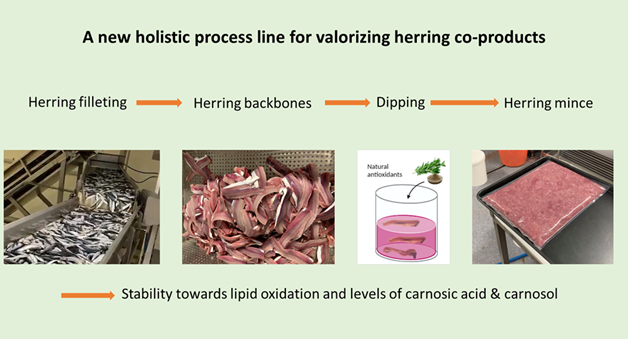Pilot-scale antioxidant dipping of herring (Clupea harengus) co-products to allow their upgrading to a high-quality mince for food production
New publication: Studies the stabilizing effect of pre-dipping herring backbones in rosemary-derived antioxidant solutions
Atlantic herring (Clupea harengus) is captured at an average of 2,162 thousand tons per year and was ranked the 4th most landed fish worldwide between 1950 and 2017.
Interestingly, this species yields a very low climate footprint with only 0.7 kilograms CO2 equivalents per kilogram, similar to soy beans. It also provides essential amino acids, minerals (e.g., iodine, selenium, calcium, and iron/heme-iron), vitamins E, D, and B12, as well as the n-3 polyunsaturated fatty acids (PUFAS) eicosapentanoic, docosahexoenoic, and docosapentoenoic acids (EPA, DPA and DHA).
Thus, herring is a very interesting contribution to the ongoing dietary protein shift in which consumers seek sustainable and nutritious alternatives to red meat. The general demand for seafood is also steadily increasing because of dietary recommendations and population growth; herring could here play a larger role than it does today.
We recently reported that processing of round herring into fillets yields ~60% co-products comprising backbone, head, viscera, belly flap, and tail. Based on their high levels of residual muscle, the herring backbones have been identified as particularly promising for valorization into food products. A simple and low-cost technique to convert relatively clean fish co-product parts into an intermediate ready-to-use product is mechanical meat-bone separation. Mechanically separated muscle (MSM) has revealed great potential to be converted e.g., into fish burgers, fish balls, nuggets etc.
However, when derived from herring, the high levels of heme-proteins and PUFA give rise to rapid lipid oxidation (i.e., rancidity), something which we across several studies have detected sensorially and chemically already within 1 day on ice.
We here studied the stabilizing effect of pre-dipping herring backbones in rosemary-derived antioxidant solutions prior to MSM-production. An important aim was to confirm whether our findings from lab-scale experiments also applied to pilot-scale scenarios comprising up to 500kg backbones.

To ensure that the treatments were in line with EFSA legislations around the two key rosemary-derived antioxidants carnosol and carnosic acid, levels of these compounds were monitored during dipping and subsequent storage. Pre-dipping backbones in Duralox MANC extended the oxidation lag phase of the MSM from <1 to 12 days during ice storage and from <1 to 6 months during frozen storage compared to control.
With rosemary extract (+/- isoascorbic acid) the oxidation lag phase was extended to 6 days and 9 months during ice and frozen storage, respectively. Maximum levels carnosol+carnosic acid found in the MSM was 31.7 mg/kg, which is far below the EFSA-limits. Results confirmed, in pilot scale, that pre-dipping herring co-products in rosemary extract containing solutions is a promising strategy to build a new type of herring value chain comprising mince and burger production rather than using these materials for low value products as fish meal.
The paper is authored by Haizhou Wu, John Axelsson, Rikard Fristedt, Ingrid Undeland from the Department of Biology and Biological Engineering - Food and Nutrition Science at Chalmers University of Technology and Martin Kuhlin from Pelagic Sweden AB.
The paper has been published with open access in the journal ACS Sustainable Chemistry & Engineering, which you can read here.